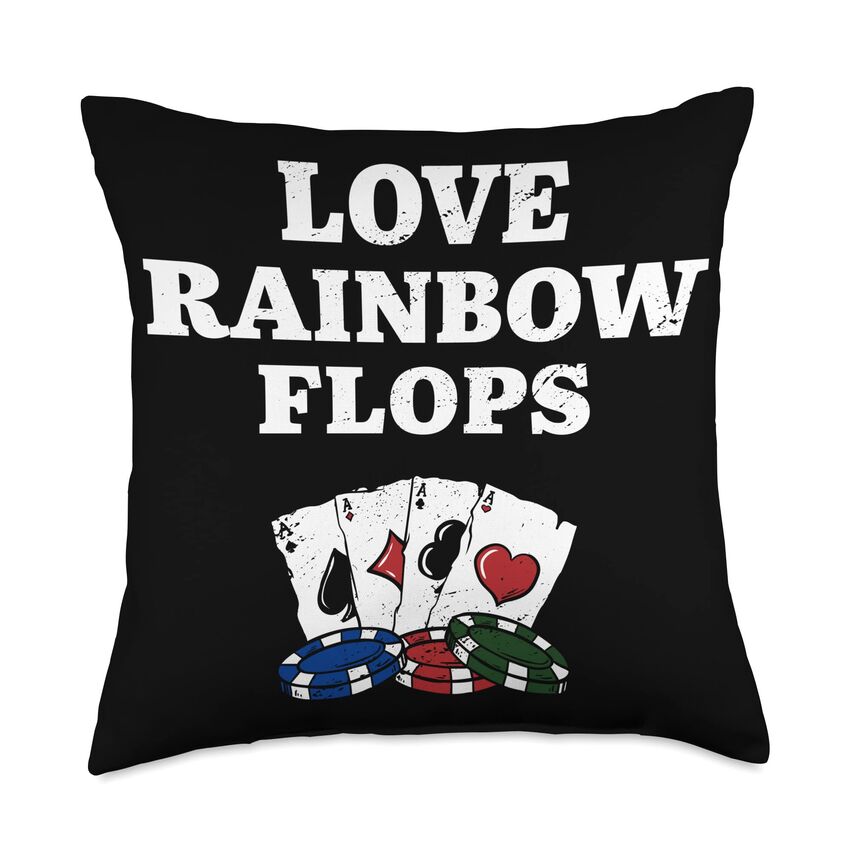When you think of a rainbow, a colourful arch stretching across the sky comes to mind. However, the term rainbow has its meaning in the poker world. What is a rainbow in poker? In poker, a rainbow is a type of flop with three cards of different suits, meaning no player can complete a flush on the turn.
Furthermore, the term rainbow can also refer to a full five-card community board where no more than two cards share the same suit, making it impossible to complete a flush. This comprehensive article will explore the concept of a "rainbow" in poker and how it adds complexity and excitement to the game.

Different Rainbow Flop Scenarios
Let's look at a couple of potential instances to see how rainbow flops work:
Scenario 1: You're in a late position, and the flop comes 5♦ 3♠ 9♥ (a rainbow flop). You hold 8♣ 6♣, giving you a straight draw. There are two players ahead of you who both check. In this situation, you might consider placing a bet to represent a strong hand and potentially steal the pot.
Scenario 2: You're in an early position with Q♠ K♠, and the flop comes 2♦ 7♣ J♠. While you didn't connect with the flop, the rainbow nature of the board means there's a lower chance that your opponents have a strong hand. Consider making a continuation bet to test the waters and gather information about your opponents' hands.
Rainbow flops add a colorful twist to poker, where all three community cards are of different suits. You will likely encounter several rainbow flops on the top online poker platforms like AmericasCardroom, GG Poker, and 888 Poker.
Strategies for Playing Rainbow Boards
Most players have difficulty navigating rainbow flops. The probability of a rainbow on the board depends on the number of suits represented in the flop. Since there are four suits in a standard deck, the likelihood of a rainbow flop is approximately 40%. Hence poker players must know how to play in rainbow flops since they will encounter such flops 40% of the time. Below are different ways to maneuver rainbow flops effectively.
Hand Selection

Consider slightly widening your playable hand range when encountering a rainbow flop. Since your opponents are less likely to complete their flush draws, you can be more confident in the strength of your non-flush hands. If the board has high cards or connects well with your potential range, it may be a good time to widen your range. On the other hand, if the flop is low and uncoordinated, it may not be as profitable to play marginal hands.
Bet Sizing
Pay attention and employ the correct bet sizing. Calculating pot odds becomes more straightforward with reduced flush possibilities. Make sure your bets are aligned with the value of your hands and the likelihood for your opponents to either call or fold.

Bluffing
Rainbow flops offer excellent spots to execute well-timed bluffs. Your opponents could be more susceptible to your bluffs since they are less likely to have strong flush draws. However, carefully examine your opponent's tendencies before deciding to bluff. Representing a strong hand on a rainbow flop can be highly effective. Your opponents could be more likely to fold if you've played aggressively throughout the hand because they believe you hit a strong hand on the flop. You can work on broadening your bluffs on rainbow boards on PokerStars.
Pot Control
Although a rainbow board may encourage aggressiveness, proceed with caution whenever needed. If you have a weak hand or are unclear of your opponent's strength, try checking or calling to see the turn card without increasing the pot size. This technique helps you to collect more information and make more informed decisions. If your opponents show aggression and you suspect they hold a strong hand, folding your marginal holdings is okay, saving your chips for better opportunities.
| Player’s Hand | Opponents Action | Recommended Move |
|---|---|---|
| Two Pair | Opponent bets aggressively | Raise for value |
| High Card | Opponent check | Consider a bluff |
| Middle Pair | Opponent overbet | Fold |
| Set | Opponent bets moderately | Raise |
Example of strategies for different Rainbow flop scenarios
Common Mistakes to Avoid on Rainbow Flops
- Overvaluing Weak Hands: One common mistake players make on rainbow flops is overvaluing their weak hands. The lack of flush draws can lead players to assume that non-suited cards are stronger than they are. This erroneous assumption might result in costly bets and losses.
- Ignoring Potential Straights: Although the possibility of flush draws is eliminated on rainbow flops, players should still consider the potential straight draws. If the flop has three consecutive cards, it's possible for a player holding two suited hole cards to complete a straight with the turn and river cards.

Summary
Understanding different board textures, particularly Rainbow Boards, is vital for serious poker players. These distinct board textures may help you analyze opponents, extract value, and bluff successfully. You'll be more prepared to manage the ever-changing poker environment and increase your win rate. Good luck at the tables.
Have any questions? Feel free to contact our support:
- Increased rakeback and personal bonuses
- Help with deposits and cashouts
- Access to mobile applications
- Solving problems with accounts
- Technical support
- Questions about the site and forum























